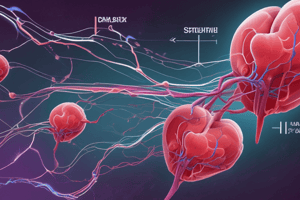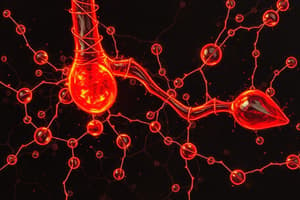Podcast
Questions and Answers
What role does nitric oxide (NO) play in cardiovascular protection?
What role does nitric oxide (NO) play in cardiovascular protection?
- It facilitates vasodilatation and inhibits platelet aggregation. (correct)
- It enhances the production of reactive oxygen species.
- It prevents all forms of cell apoptosis.
- It solely regulates blood pressure.
Which factor is indicated to increase resistance to nitric oxide in the cardiovascular system?
Which factor is indicated to increase resistance to nitric oxide in the cardiovascular system?
- Decreased reactive oxygen species.
- Increased production of NO synthase.
- Excessive mitochondrial function.
- Elevated levels of arginase 2. (correct)
What is a possible mechanism by which nitric oxide is thought to protect the heart during ischaemia?
What is a possible mechanism by which nitric oxide is thought to protect the heart during ischaemia?
- Supporting mitochondrial function. (correct)
- Enhancing the regenerative capacity of heart tissue.
- Increasing calcium ion concentration in cardiac cells.
- Directly inhibiting the action of vasoconstrictors.
How can nitric oxide signalling potentially be increased as a therapeutic approach?
How can nitric oxide signalling potentially be increased as a therapeutic approach?
Which pathway is primarily involved in the vasodilatory actions of nitric oxide?
Which pathway is primarily involved in the vasodilatory actions of nitric oxide?
Which of the following therapies primarily activates eNOS?
Which of the following therapies primarily activates eNOS?
What is a potential therapeutic strategy to prevent the breakdown of nitric oxide?
What is a potential therapeutic strategy to prevent the breakdown of nitric oxide?
Which substance is recognized as a signaling molecule downstream of nitric oxide?
Which substance is recognized as a signaling molecule downstream of nitric oxide?
Which of the following is NOT a method to enhance nitric oxide synthesis?
Which of the following is NOT a method to enhance nitric oxide synthesis?
Which factor is primarily associated with endothelial dysfunction in cardiovascular disease?
Which factor is primarily associated with endothelial dysfunction in cardiovascular disease?
What role does nitric oxide play in cardiovascular disease?
What role does nitric oxide play in cardiovascular disease?
Which of the following substances is NOT involved in signaling pathways stimulated by nitric oxide?
Which of the following substances is NOT involved in signaling pathways stimulated by nitric oxide?
Which therapeutic target is emerging for pulmonary hypertension associated with soluble Guanylate Cyclase?
Which therapeutic target is emerging for pulmonary hypertension associated with soluble Guanylate Cyclase?
Nitric oxide (NO) promotes platelet aggregation and adhesion in cardiovascular health.
Nitric oxide (NO) promotes platelet aggregation and adhesion in cardiovascular health.
Increased arginase 2 activity is associated with reduced nitric oxide production and contributes to cardiovascular disease.
Increased arginase 2 activity is associated with reduced nitric oxide production and contributes to cardiovascular disease.
Nitric oxide exerts negative inotropic effects, decreasing heart contractility.
Nitric oxide exerts negative inotropic effects, decreasing heart contractility.
The regulation of nitric oxide signaling is independent of the basal redox state.
The regulation of nitric oxide signaling is independent of the basal redox state.
Mitochondria play a significant role in the cardioprotective effects of nitric oxide during ischemia.
Mitochondria play a significant role in the cardioprotective effects of nitric oxide during ischemia.
Endothelial dysfunction does not play a role in cardiovascular disease (CVD).
Endothelial dysfunction does not play a role in cardiovascular disease (CVD).
L-arginine is used to enhance nitric oxide (NO) synthesis by direct delivery or inhibiting arginase.
L-arginine is used to enhance nitric oxide (NO) synthesis by direct delivery or inhibiting arginase.
Statins are considered a method to prevent the breakdown of nitric oxide (NO).
Statins are considered a method to prevent the breakdown of nitric oxide (NO).
The stimulation of soluble guanylate cyclase (sGC) is a strategy to increase nitric oxide (NO) signaling in cardiovascular diseases.
The stimulation of soluble guanylate cyclase (sGC) is a strategy to increase nitric oxide (NO) signaling in cardiovascular diseases.
Polyphenols have no known connection to nitric oxide (NO) synthesis.
Polyphenols have no known connection to nitric oxide (NO) synthesis.
Corticosteroids are included in current therapies that activate endothelial nitric oxide synthase (eNOS).
Corticosteroids are included in current therapies that activate endothelial nitric oxide synthase (eNOS).
2nd generation β blockers inhibit the synthesis of nitric oxide (NO).
2nd generation β blockers inhibit the synthesis of nitric oxide (NO).
The breakdown of nitric oxide (NO) can be inhibited by ACE inhibitors.
The breakdown of nitric oxide (NO) can be inhibited by ACE inhibitors.
Study Notes
Nitric Oxide and Cardiovascular Disease
- Reduced nitric oxide (NO) levels linked to cardiovascular disease (CVD) risk factors.
- Endothelial dysfunction is characterized by impaired NO production and signaling, leading to increased CVD susceptibility.
Protective Mechanisms of NO against CVD
- NO promotes vasodilation through the soluble guanylate cyclase (sGC) and cGMP pathway.
- Inhibits platelet aggregation and monocyte adhesion, reducing thrombus formation.
- Suppresses smooth muscle cell and fibroblast proliferation, mitigating vascular remodeling.
Cardioprotective Effects of NO
- Regulates heart rate and contractility through positive inotropic effects mediated by cGMP and ryanodine receptors.
- Plays a role in protecting heart cells during ischemic events, though the precise mechanisms remain unclear.
- Mitochondria may be crucial in mediating the cardioprotective actions of NO.
Strategies to Enhance NO/cGMP Signaling
- Direct generation of NO through inhalation is used for treating persistent pulmonary hypertension in newborns.
- Enhance NO synthesis via:
- L-arginine supplementation and arginase inhibition.
- Supplementation with tetrahydrobiopterin (BH4).
- Inhibition of endogenous NO synthase (NOS) inhibitors.
- Activating endothelial NOS (eNOS) through current therapies like statins, corticosteroids, and second-generation β-blockers.
Preventing NO Breakdown
- Use ACE inhibitors and NOX inhibitors to maintain NO levels in the cardiovascular system.
Downstream Pathway Stimulation
- Utilize ANP and NEP to enhance NO signaling and induce vasodilation.
- Phosphodiesterase inhibitors (PDE) such as sildenafil (PDE5i) and BAY60-5770 (PDE2i) can amplify the effects of cGMP.
Nutritional Aspects
- Polyphenols have been shown to positively influence NO levels and cardiovascular health.
Clinical Implications
- Understanding risk factors for NO reduction and linking it to CVD is crucial for prevention and treatment.
- Strategies to enhance NO signaling could provide therapeutic benefits in managing cardiovascular diseases.
Nitric Oxide and Cardiovascular Disease
- Reduced nitric oxide (NO) levels linked to cardiovascular disease (CVD) risk factors.
- Endothelial dysfunction is characterized by impaired NO production and signaling, leading to increased CVD susceptibility.
Protective Mechanisms of NO against CVD
- NO promotes vasodilation through the soluble guanylate cyclase (sGC) and cGMP pathway.
- Inhibits platelet aggregation and monocyte adhesion, reducing thrombus formation.
- Suppresses smooth muscle cell and fibroblast proliferation, mitigating vascular remodeling.
Cardioprotective Effects of NO
- Regulates heart rate and contractility through positive inotropic effects mediated by cGMP and ryanodine receptors.
- Plays a role in protecting heart cells during ischemic events, though the precise mechanisms remain unclear.
- Mitochondria may be crucial in mediating the cardioprotective actions of NO.
Strategies to Enhance NO/cGMP Signaling
- Direct generation of NO through inhalation is used for treating persistent pulmonary hypertension in newborns.
- Enhance NO synthesis via:
- L-arginine supplementation and arginase inhibition.
- Supplementation with tetrahydrobiopterin (BH4).
- Inhibition of endogenous NO synthase (NOS) inhibitors.
- Activating endothelial NOS (eNOS) through current therapies like statins, corticosteroids, and second-generation β-blockers.
Preventing NO Breakdown
- Use ACE inhibitors and NOX inhibitors to maintain NO levels in the cardiovascular system.
Downstream Pathway Stimulation
- Utilize ANP and NEP to enhance NO signaling and induce vasodilation.
- Phosphodiesterase inhibitors (PDE) such as sildenafil (PDE5i) and BAY60-5770 (PDE2i) can amplify the effects of cGMP.
Nutritional Aspects
- Polyphenols have been shown to positively influence NO levels and cardiovascular health.
Clinical Implications
- Understanding risk factors for NO reduction and linking it to CVD is crucial for prevention and treatment.
- Strategies to enhance NO signaling could provide therapeutic benefits in managing cardiovascular diseases.
Studying That Suits You
Use AI to generate personalized quizzes and flashcards to suit your learning preferences.
Related Documents
Description
This quiz covers the critical role of nitric oxide (NO) in cardiovascular health, examining its protective effects against cardiovascular disease (CVD) and the mechanisms behind endothelial dysfunction. Additionally, it explores potential therapeutic strategies to enhance NO signaling, referencing valuable research from Lundberg et al., 2015.




